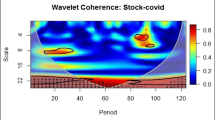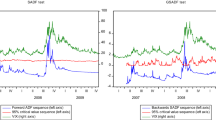Abstract
Tracking market fear in distress periods is a highly challenging and essential task of paramount practical relevance. If the future figures of market fear can be predicted in conjunction with explaining the dependence structure on predictor variables, market players at different levels can be benefited. The current work endeavors to model the Chicago Board Options Exchange’s Volatility Index (CBOE VIX) of the US, reflecting the extent of market fear in the futures market through the lens of applied predictive modeling and explainable artificial intelligence (AI). The methodological framework deploys two advanced forecasting tools, namely, Facebook Prophet and Uber Orbit, to gauge the temporal pattern of the CBOE VIX. The exercises have been carried out across different regimes characterized by varying degrees of volatility and uncertainty. It is revealed that the market fear in the US was relatively more predictable during the Pre-COVID-19 phase. The outcome of explainable AI analysis using Shapley additive explanations (SHAP) and accumulated local effect (ALE) plots indicates the past information of CBOE VIX exerts significant predictive influence, which largely explains the variation.
Access this chapter
Tax calculation will be finalised at checkout
Purchases are for personal use only
Similar content being viewed by others
References
Apley, D.W., Zhu, J.: Visualizing the effects of predictor variables in black box supervised learning models. J. Roy. Stat. Soc. Ser. B 82, 1059–1086 (2020)
Ashtiani, M.N., Raahemi, B.: News-based intelligent prediction of financial markets using text mining and machine learning: a systematic literature review. Expert Syst. Appl. 217, 119509 (2023)
Chen, X., Feng, J., Wang, T.: Pricing VIX futures: a framework with random level shifts. Finance Res. Lett. 52, 103501 (2023)
Fiandrino, C., Attanasio, G., Fiore, M., Widmer, J.: Toward native explainable and robust AI in 6G networks: current state, challenges and road ahead. Comput. Commun. 193, 47–52 (2022)
Ghosh, I., Datta Chaudhuri, T.: Integrating Navier-Stokes equation and neoteric iForest-BorutaShap-Facebook’s prophet framework for stock market prediction: an application in Indian context. Expert Syst. Appl. 210, 118391 (2022)
Ghosh, I., Datta Chaudhuri, T., Alfaro-Cortés, E., Gámez, M., García, N.: A hybrid approach to forecasting futures prices with simultaneous consideration of optimality in ensemble feature selection and advanced artificial intelligence. Technol. Forecast. Soc. Change 181, 121757 (2022)
Jana, R.K., Ghosh, I., Das, D.: A differential evolution-based regression framework for forecasting Bitcoin price. Ann. Oper. Res. 306, 295–320 (2021)
Jana, R.K., Ghosh, I., Wallin, M.W.: Taming energy and electronic waste generation in bitcoin mining: insights from Facebook prophet and deep neural network. Technol. Forecast. Soc. Change 178, 121584 (2022)
John, K., Li, J.: COVID-19, volatility dynamics, and sentiment trading. J. Bank. Finance 133, 106162 (2021)
Lu, X., Ma, F., Wang, J., Wang, J.: Examining the predictive information of CBOE OVX on China’s oil futures volatility: evidence from MS-MIDAS models. Energy 212, 118743 (2020)
Lundberg, S., Lee, S.I.: A unified approach to interpreting model predictions. ar**v:1705.07874 (2017)
Mi, J., Wang, L.F., Liu, Y., Zhang, J.: KDE-GAN: a multimodal medical image-fusion model based on knowledge distillation and explainable AI modules. Comput. Biol. Med. 151A, 106273 (2022)
Ng, E., Wang, J., Chen, H., Yang, S., Smyl, S.: Orbit: probabilistic forecast with exponential smoothing. ar**v:2004.08492, https://doi.org/10.48550/ar**v.2004.08492 (2020)
Qiao, G., Jiang, G., Yang, J.: VIX term structure forecasting: new evidence based on the realized semi-variances. Int. Rev. Financ. Anal. 82, 102199 (2022)
Shahparast, H., Hamzeloo, S., Safari, E.: An incremental type-2 fuzzy classifier for stock trend prediction. Expert Syst. Appl. 212, 118787 (2023)
Shapley, L.S.: Stochastic games. PNAS 39, 1095–1100 (1953)
Taylor, S.J., Letham, B.: Forecasting at scale. Am. Stat. 72, 37–45 (2018)
Toochaei, M.R., Moeini, F.: Evaluating the performance of ensemble classifiers in stock returns prediction using effective features. Expert Syst. Appl. 213C, 119186 (2023)
Wang, J., Lu, X., He, F., Ma, F.: Which popular predictor is more useful to forecast international stock markets during the coronavirus pandemic: VIX vs EPU? Int. Rev. Financ. Anal. 72, 101596 (2020)
Wei, Y., Liang, C., Li, Y., Zhang, X., Wei, G.: Can CBOE gold and silver implied volatility help to forecast gold futures volatility in China? Evidence based on HAR and Ridge regression models. Finance Res. Lett. 35, 101287 (2020)
Yang, G., Ye, Q., **a, J.: Unbox the black-box for the medical explainable AI via multi-modal and multi-centre data fusion: a mini-review, two showcases and beyond. Inf. Fus. 77, 29–52 (2022)
Author information
Authors and Affiliations
Corresponding author
Editor information
Editors and Affiliations
Rights and permissions
Copyright information
© 2024 The Author(s), under exclusive license to Springer Nature Switzerland AG
About this paper
Cite this paper
Desetti, S.S., Ghosh, I. (2024). Prediction and Deeper Analysis of Market Fear in Pre-COVID-19, COVID-19 and Russia-Ukraine Conflict: A Comparative Study of Facebook Prophet, Uber Orbit and Explainable AI. In: Dasgupta, K., Mukhopadhyay, S., Mandal, J.K., Dutta, P. (eds) Computational Intelligence in Communications and Business Analytics. CICBA 2023. Communications in Computer and Information Science, vol 1955. Springer, Cham. https://doi.org/10.1007/978-3-031-48876-4_16
Download citation
DOI: https://doi.org/10.1007/978-3-031-48876-4_16
Published:
Publisher Name: Springer, Cham
Print ISBN: 978-3-031-48875-7
Online ISBN: 978-3-031-48876-4
eBook Packages: Computer ScienceComputer Science (R0)




